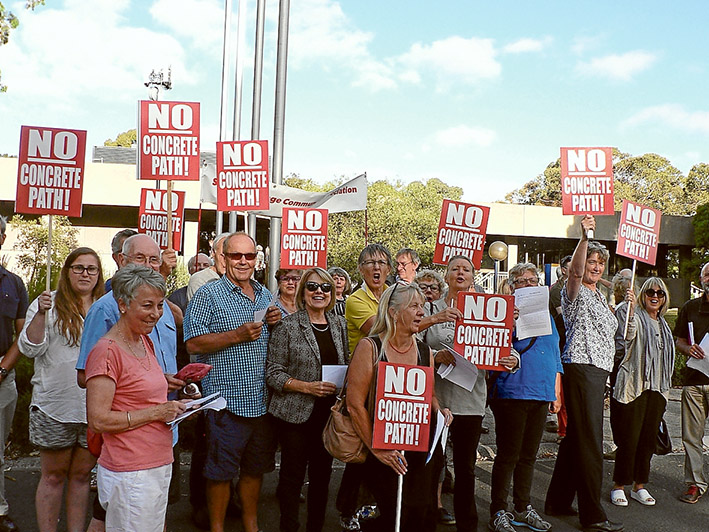
RATEPAYERS on the Mornington Peninsula could be required to contribute to special charge schemes for footpaths in their area but never get one built past their house.
This could occur if the Somers model – charging almost an entire community for a single footpath to be built – became a template for other areas, shire chief operating officer Alison Leighton told council’s 8 February meeting.
The Somers path is two kilometres away from some properties being asked to pay.
“It’s not something that I can unambiguously rule out,” Ms Leighton said in answer to a question from David Gill, a leading opponent of the Somers plan.
Mr Gill later said Somers Village Community Association intends taking the matter to the Victorian Civil and Administrative Tribunal (VCAT).
He said the motion to proceed with the concrete paths was moved by Red Hill ward councillor, Tim Wood who he believed “did little to put any case for his constituents”.
“His effort was laughed at by the large gallery of people who can claim to be representing Somers after submitting 500 signatures opposing the 5.2 kilometre concrete path scheme,” Mr Gill said.
“The Somers Village Community Association is demanding an investigation into council methods used to influence people effected by the concrete paths scheme. This includes council paying for delivery of pamphlets [containing incorrect information] instigated by a group supporting the scheme.”
Ms Leighton said she was not aware of any other “area-wide” footpath projects being proposed, “but obviously it’s open to future councils of the day to make decisions around those kinds of projects”.
Such “area-wide” projects could also be proposed in urban areas of the peninsula.
The Somers footpath is contentious because it radically expands the catchment area of property owners who will be required to contribute to the special charge scheme. Some 1245 Somers properties will be levied: only a few are excluded.
Until now only owners of properties directly abutting a new footpath, or on the opposite side of the road to it, have been required to pay the charge. This is because they get, as the Local Government Act requires, a “special benefit” from the footpath (section 163).
A number of council websites emphasise this to be their understanding of the legislation. Yarra Ranges council states: “A special charge scheme is generally introduced where the works proposed are to the special benefit of a defined group of properties.
“Properties sharing a boundary with the works will generally receive special benefits such as … improved property access, improved road safety, and general property amenity improvement.”
Before – and since – the Somers scheme was proposed, other peninsula footpath proposals have required payment only from properties fronting the street where the path will be built. These include a McCrae proposal, in which some property owners got a 20 per cent discount on grounds that remain puzzling.
The shire rationale was that the proposed path in one street was also used by residents from a more distant area, on the eastern side of the freeway. However, these users were not identified or quantified and no attempt was made to impose a special charge on them, as is occurring with Somers’ distant residents.
Further, these McCrae pedestrians will also benefit from other sections of the new footpath, but properties adjoining those paths did not get any discount on their share of the cost.
The state government proposal to cap council rates at about the inflation rate could be the impetus for this new strategy. Money raised by special charge schemes is excluded from the rate cap, as are municipal waste charges. Currently the shire does not have a waste charge separate from the annual rates and charges bill.
A ministerial guideline on special charge schemes issued in 2004 stated they were intended “to ensure councils retain the ability to recover reasonable contributions from people who will derive special benefits from particular works or services so that those special benefits do not need to be subsidised by general ratepayers”.
Several city law firms specialising in local government have indicated that councils may be able to sidestep the rate cap. One, Macquarie Local Government Lawyers, suggests councils can use special charge schemes “for any purpose considered to be within the attainment of their objectives”.
The act is being substantially revised, possibly to close loopholes that would subvert the rate cap policy.
It states councils may declare these schemes for “a function or the exercise of a power” if it considers that the scheme “will be of special benefit” to those required to pay for it.
Councils have long taken this to apply to a limited number of works where the special benefit test applies. Yarra Ranges Shire’s website lists projects such as roads, footpaths and drainage, adding that such a scheme “may also be considered for township development and traffic management projects”.
First published in the Southern Peninsula News – 16 February 2016